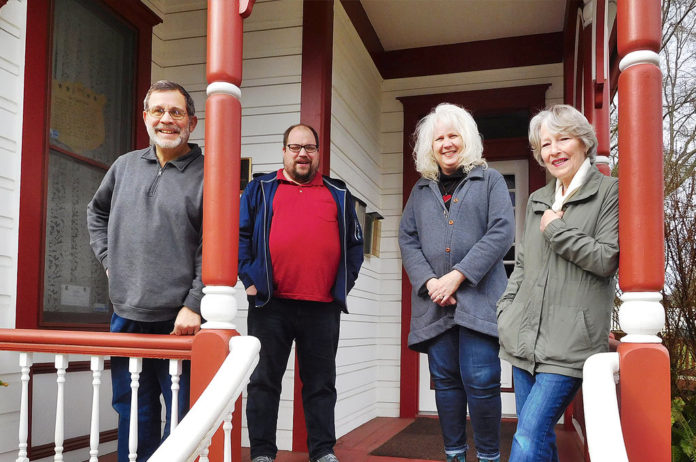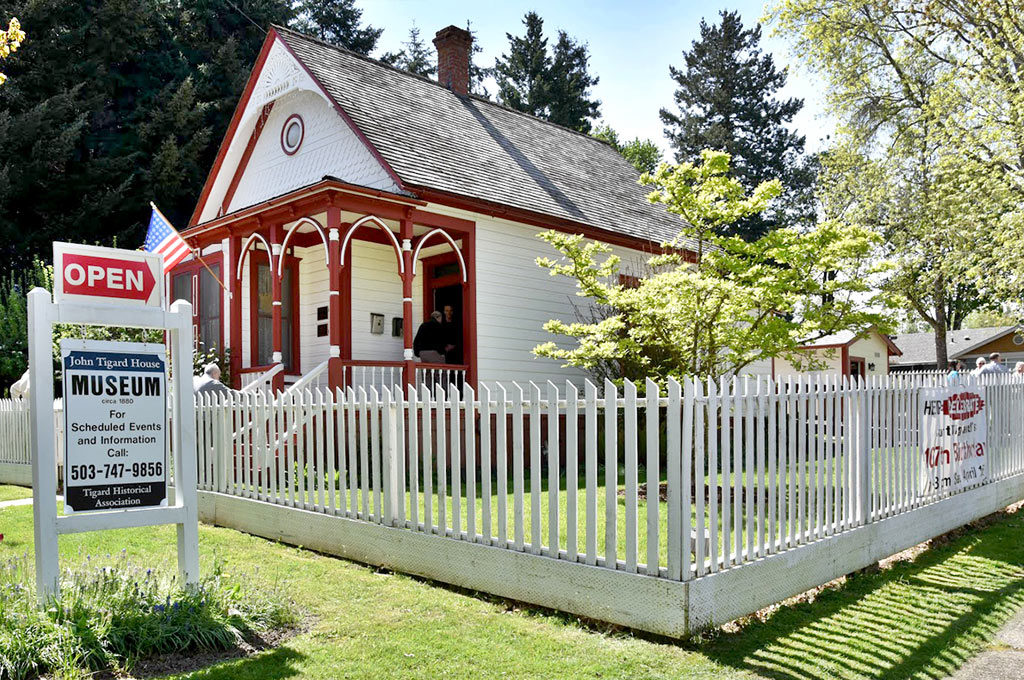
Volunteers preserve 1882 John Tigard House, and more, to share with future generations
Believe it or not, one of the most exciting and dramatic events in Tigard history marked the formation of the Tigard Historical Association (THA) in 1978, when the John Tigard House was about to be torn down. Several concerned people stood in front of the old house and used their bodies to block bulldozers about to demolish the building. At that time it stood at the corner of Gaarde Street and 99W, which was in the process of being widened for development. One of those brave people was LaVerne Sharp, who went on to found THA.
“She stood in front of the bulldozers and said, ‘you can’t tear that down, it’s Tigard’s history,’” explains Martha Worley, president of the Association for five years and secretary since 1991. John Tigard House was subsequently moved to the corner of 103rd and Canterbury Lane, across the street from Calvin Presbyterian Church, where it stands to this day. Now beautifully restored inside and out, surrounded by a classic white picket fence and with a small grove of apple trees in the yard, it looks nothing like that it did on that eventful day in 1978.
“They saved the house,” says Martha, “but it looked bad, very bad. So to preserve and restore the house she got a group together called Tigard Area Historical and Preservation Association (TAHPA), which eventually we changed to Tigard Historical Association, because TAHPA sounded like a tap dance group. That was in 1979, which was when they moved the house to its present location. The house stood across the street on the Calvin Presbyterian Church parking lot until the site was prepared for it. The land at that time was owned by the Tigard Water District, who leased it to us for a dollar a year. That was a pretty doggone good price. The property is now owned by the city of Tigard and they graciously mow the lawn, keep the sidewalks in good repair, and prune the apple trees.”
The family of Wilson and Polly Tigard came to Oregon along the Oregon Trail, arriving in 1852. Under the Federal Homestead Act they jointly claimed 320 acres (160 acres each) in what is now Tigard. Land claim terms required them to improve the property and put it to use.
“They landed in Oregon City at the end of the Oregon Trail, and then wandered around looking for where they wanted to settle,” explains Martha. “This was a perfect spot for them. It was close enough to the Tualatin River, and there was great lumber available on the timbered properties. There was a road into Portland. They called it the corduroy road, because the logs were laid side-by-side all the way into Portland. It was a very bumpy ride, but you could get there.
“This house was built in 1882 for Wilson Tigard’s oldest child John, who came with them across the Oregon Trail, along with Polly’s mother. This was his wedding present. After they got to Oregon they had five girls and four more boys. Most people had big families back then, because with 300 acres there was a lot of work to do,” says Martha.
Tigard Historical Association may have formed to preserve the John Tigard House, but when that task was completed, the focus shifted to identifying and preserving more of Tigard’s rapidly vanishing history, and to serving as an educational group, informing new generations about their town’s history, using John Tigard House to provide a hands-on “living history” experience. As the years have turned into decades, more people have joined the group and become active historians and educators.
“I’ve always been interested in history, and my daughter Olivia, 8, is also very excited about history, so we came to John Tigard house for an event and have been hooked ever since,” explains Mike McInnis, an eight year Tigard resident who volunteers with THA to create the quarterly newsletter and handle publicity. “I see the John Tigard house as an opportunity to keep our history preserved. It also gives an example to show the living history we have around us so people can come in to see what it was like to live in the 1800s.
“The Historical Association really works to preserve what history is left in Tigard,” says Mike. “A lot of it was lost in the ‘70s and ‘80s. That’s how the organization got started, saving the John Tigard House. I just found out last week that my family homesteaded in Durham in the 1850s. They traveled from England to New York, and then to St. Louis and on to Oregon, settling in Durham.”

Besides giving tours of the John Tigard House, THA has expanded to holding events designed to involve Tigard residents in celebrations of their city’s history. Phillip Pasteris, THA Board member and semiprofessional photographer, is the group’s official photographer and webmaster, and he says his primary volunteer duty is documenting and preserving THA events and special occasions. He’s been a volunteer for eight years, explaining with a laugh that after living in Tigard 30 years he decided he was qualified to join THA.
“I’ve taken pictures when Curtis Tigard has been here,” says Phil. Curtis Tigard, who turns 108 this year, is a regular at the John Tigard House, which was built for his uncle. Celebrating Curtis’s birthday has become an annual event at John Tigard House. Phil and his camera are almost always present whenever something is happening at John Tigard House.
“Besides Curtis’s birthday, we have the Ice Cream Social, the Apple Harvest, and the Victorian Christmas,” explains Phil. “We offer pictures free on our website, where people can download them. In the summer we set up in front of the house with chairs and an old barrel and period costumes visitors can dress up in. I’ll take their picture standing in front of the house, with props like a long rifle or fancy hat, and put them on the website where they can download them and use them as they wish.
“We probably need to do more to make our Association known to the public, and build awareness of what’s going on,” adds Phil. “We do have good crowds. We’ve had 150 to 200 people show up for these events. People need to know where we came from and what it was like a long time ago. You can see by the old pictures on the walls of John Tigard House there’s been a lot of change. Change is always going to happen, and it’s our job to preserve what we can of our history.
“We’re not getting any younger, and we need to get younger people involved with the Tigard Historical Association, who have the time and energy to learn more about Tigard and participate in community activities,” says Phil. “Things are always going to change, and you need to be aware of what you can contribute to preserve not only the past, but the things we deal with on an everyday basis. My wife Rosemary works at Durham School, and one of her coworkers said ‘I’ve got some antique things that would be useful, can I donate them?’ So now we have a historic vintage highchair sitting in the kitchen at John Tigard House, and also some depression era glassware. We are very fortunate that we have one of Tigard’s original houses in which to store these items and share them with the public.”
To learn more about John Tigard House and the many events held there, to make a donation or get involved as a volunteer, or to arrange to visit the house, go to the website at www.TigardHistorical.org.





















